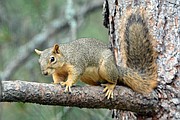Is that American red squirrel or fox squirrel?
Advice from a squirrel: Plan ahead, stay active, spend time in the woods, go out on a limb and its OK to be a little nuts.
The Fox squirrel (Sciurus niger) is typically found in the United States and Canada. This squirrel has a lot of red in its fur and many people will call this guy a red squirrel. It is easy to tell a Fox squirrel from an American Red squirrel (Tamiasciuru hudsonicus) based on size alone. Fox squirrels are the largest tree squirrel in North America and can weigh up to two pounds. American Red Squirrels are much smaller with an average weight of about half a pound.
The American Red Squirrel is one of three species that are generically called “Pine Squirrels”. These squirrels are abundant in Boundary County and across the United States with populations in the Rocky Mountains and all across Canada.
The most noticeable characteristics of the American red squirrel are the tail and the eye ring. The tree squirrel's tail is bushy and dark red with hints of a white outline. The eye ring is a thick, white circle around the rodent's black eyes. American red squirrels are about 12 inches and have grayish, red, or rust-colored fur with a white belly. Sometimes a black stripe can be seen on the sides.
American red squirrels mainly feed on the seeds and cones of evergreen trees. However, they will also eat bird eggs, berries, and fruit when they are available. During the summer, American red squirrels collect and hide seeds and nuts so they have food storage during the lean winters. Sometimes they forget to dig up the seeds. This benefits their local habitat because the squirrels are unintentionally planting trees in new places.
American red squirrels are active throughout the year. During March and April, females have litters of three to seven young. To communicate, an American red squirrel makes a lengthy, descending trill and a chatter of assorted notes and chucks.
The Fox squirrel is named for its gray and red colored fur that resembles the pelt of a fox. He makes three kinds of houses; cozy den nests in hollows of over mature trees with holes from rot or woodpeckers, comfy winter dreys (nests) and summer dreys. Den trees when available are used in the winter and are the preferred shelter because the survival rate for squirrel pups is higher in tree dens compared to leaf nests.
The Fox squirrel has short, rounded ears and a stubby neck. A fox squirrel’s tail is long, very bushy, and has yellow tips on its tail hairs. The tail can be used for a variety of functions; it can be wrapped around the squirrel for warmth, used as an aid for balance, or spread and used as a parachute. The tail is also used to communicate with other squirrels; it can indicate being playful or when exhibiting quick, jerky movements demonstrates nervousness or excitement.
They are not particularly gregarious or playful, in fact they have been described as solitary and asocial creatures, coming together only in breeding season. They have a large vocabulary, consisting most notably of an assortment of clucking and chucking sounds, not unlike some “game” birds, and they warn the listening world of approaching threats with distress screams. In the spring and fall, groups of fox squirrels clucking and chucking together can make a small ruckus. When threatening another fox squirrel, they will stand upright with their tail over their back and flick it.
The maximum life expectancy is typically 8-12 years for the Fox squirrel and 5-8 years for the American Red squirrel. Relatively few natural predators can regularly capture these adult squirrels. Of these predators, most only take Fox and American Red squirrels opportunistically. Fox and American Red squirrel predators include: bobcats, foxes, red-tailed hawks, great horned owls, weasels, and coyotes.
Discover Boundary County wildlife. Enjoy the outdoors!



